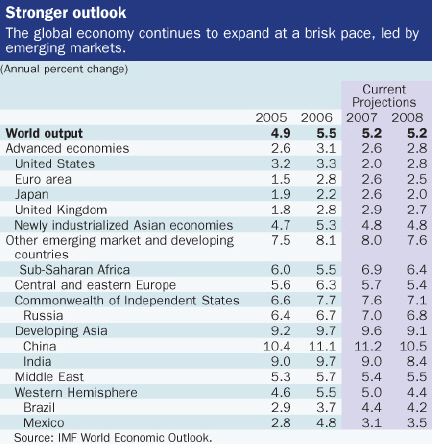
Typical street scene in Santa Ana, El Salvador. (Photo: iStock)
IMF Survey: Global Growth Seen at 5.2 pct in 2007
July 25, 2007
- Strong global expansion continuing
- Growth projections revised upward for 2007 and 2008
- Credit and market risks on the rise
The global economy continued to expand at a brisk pace in the first half of 2007, according to the July update of the IMF's World Economic Outlook (WEO).

Car production in Europe, where the IMF's World Economic Outlook update said growth was above trend (photo: Reuters)
IMF forecast
"Emerging market countries have led the way, with China growing by 11½ percent in the first half of 2007, and India and Russia also growing very strongly," Charles Collyns, Deputy Director of the IMF's Research Department, told reporters on July 25.
"Although growth in the United States slowed in the first quarter, recent indicators suggest that the U.S. economy gained strength in the second quarter. In the euro area and Japan, growth has remained above trend with some welcome signs that domestic demand is taking a more central role in the expansions," he said.
Inflation remains generally well contained despite strong global growth, although some emerging market and developing countries have faced rising price pressures especially from energy and food prices. Oil prices have risen back toward record highs against the backdrop of limited spare production capacity, while food prices have been boosted by supply shortages and increased use of biofuels, the WEO Update, published July 25, said.
Upward revisions
Against this background, global growth is now projected at 5.2 percent in 2007 and 2008—0.3 percentage points higher for both years than projected at the time of the April 2007 World Economic Outlook (see table).

The major upward revisions have been in emerging market and developing countries, with growth projections for China, India, and Russia each marked up substantially. Among the advanced economies, growth in the United States is now expected at 2 percent this year (0.2 percentage points lower than projected in the April 2007 WEO), although activity should regain momentum through the year and return to potential by mid-2008. Growth projections for the euro area, particularly Germany, and Japan have also been raised.
The overall balance of risks to the global growth outlook remains tilted modestly to the downside, as it was at the time of the April 2007 World Economic Outlook. Nevertheless, there have been some changes in the IMF staff's assessment of individual risk factors. "The risk of an oil price spike remains a concern," the Update stated.
With sustained strong growth, supply constraints are tightening and inflation risks have edged up since the April 2007 WEO, increasing the likelihood that central banks will need to tighten monetary policy further.
As discussed in the IMF's Financial Market Update, also released on July 25, financial market risks have also increased as credit quality has deteriorated in some sectors, and market volatility has increased.
Higher market risk
According to the new Financial Market Update, the clearest area in which risks have risen is credit risk, where the weakening of credit discipline identified in the IMF's April 2007 Global Financial Stability Report has resulted in rising difficulties in the U.S. subprime market and leveraged loan market.
"Delinquencies, defaults, and foreclosures have continued rising, especially in the 2006 vintages of subprime lending," said Jaime Caruana, Director of the IMF's Monetary and Capital Markets Department. "Materialization of the risks is set to continue as rising mortgage rates will translate into higher resets on adjustable-rate mortgages, many of which will reset this year and the next. Evidence of the effects of the previous weakening of credit discipline is also visible in the leveraged loan market associated with leverage buyout activity."
The Financial Market Update said recent recognition of credit risk has begun to translate into higher market risk, notably on products based on U.S. subprime mortgages and leveraged loans.
In emerging markets, the Financial Market Update said the IMF continued to see improved fundamentals and positive developments in their local capital markets, but financial vulnerabilities have continued to exist in some countries. Banks and corporations in some emerging market countries have tapped foreign capital markets leading to overly rapid borrowing, which is further complicated by their foreign currency exposures.
"In sum, risks have increased and credit markets could remain volatile in the period ahead with a further repricing of some credit products. However, so far, our assessment is that this risk is likely to remain largely contained, although further adjustments are still possible," the Financial Market Update said.


